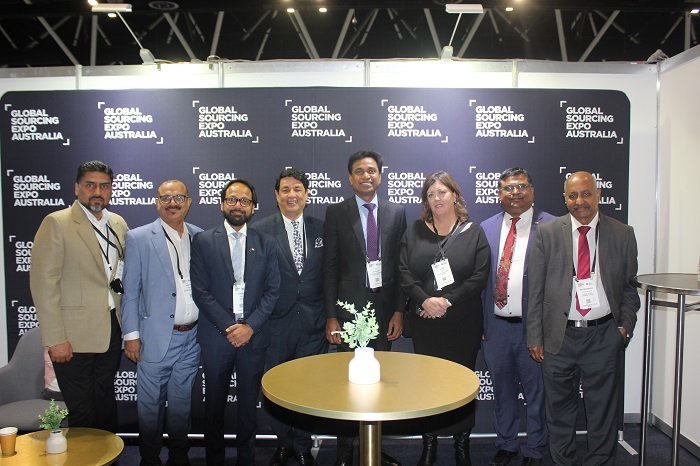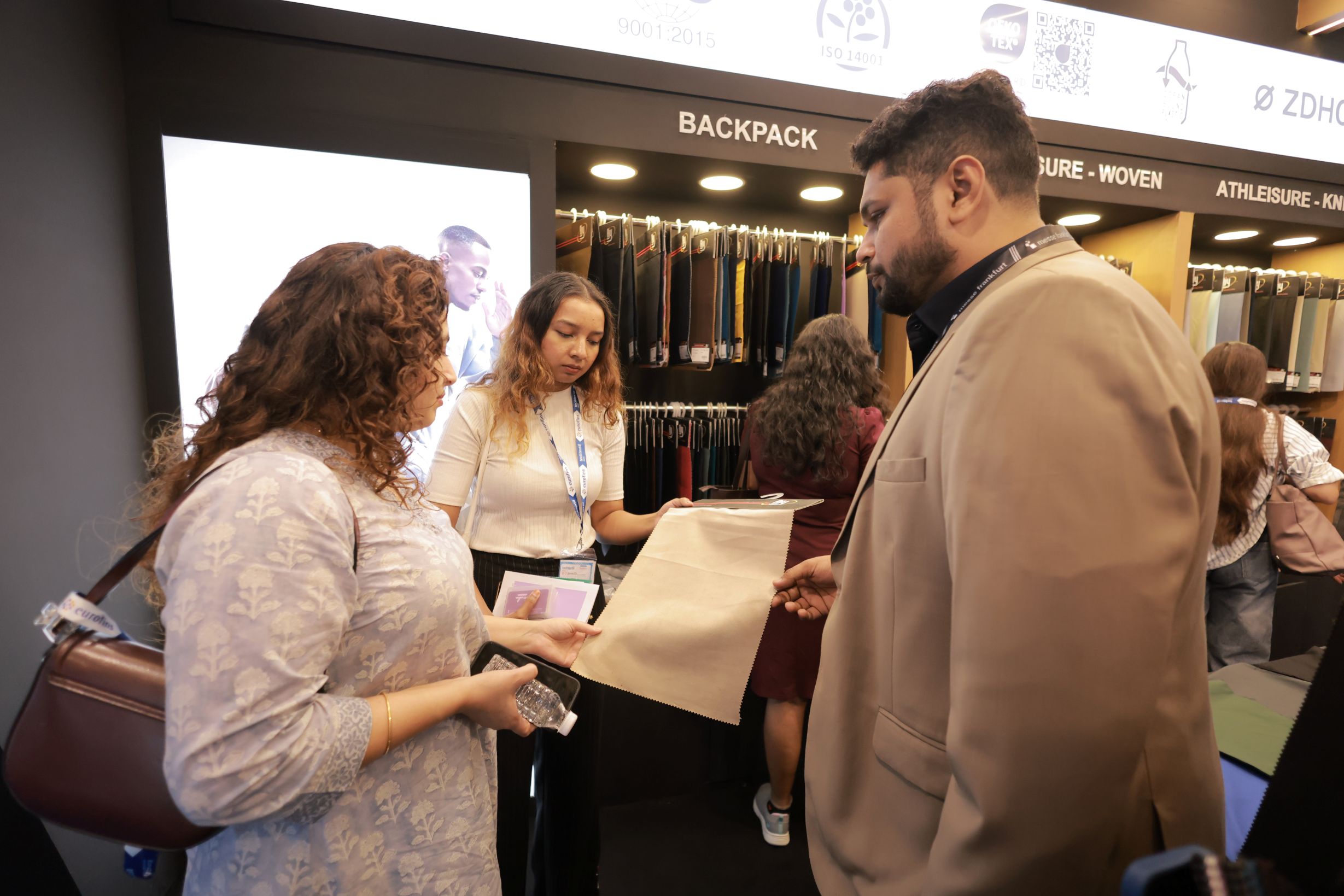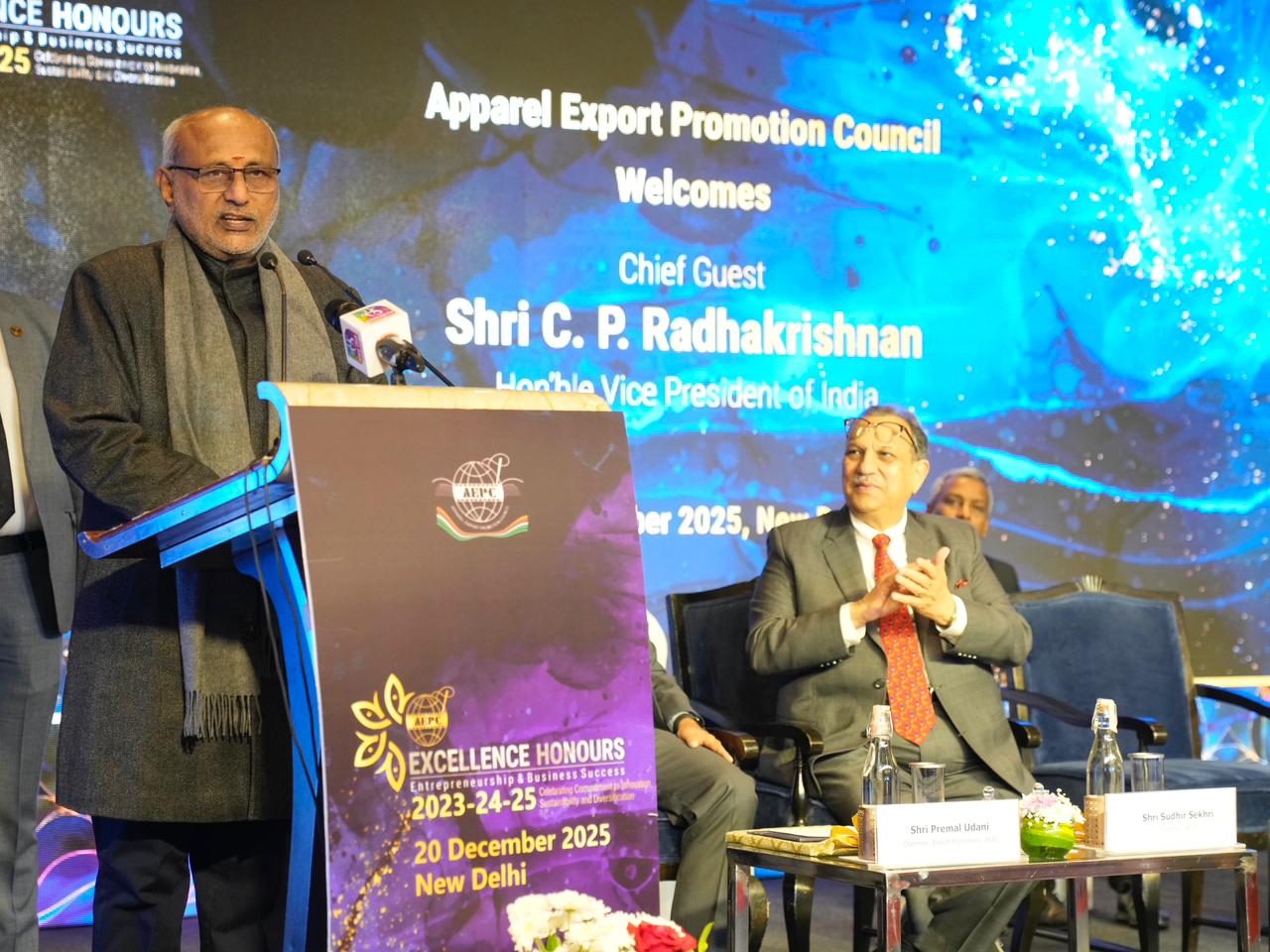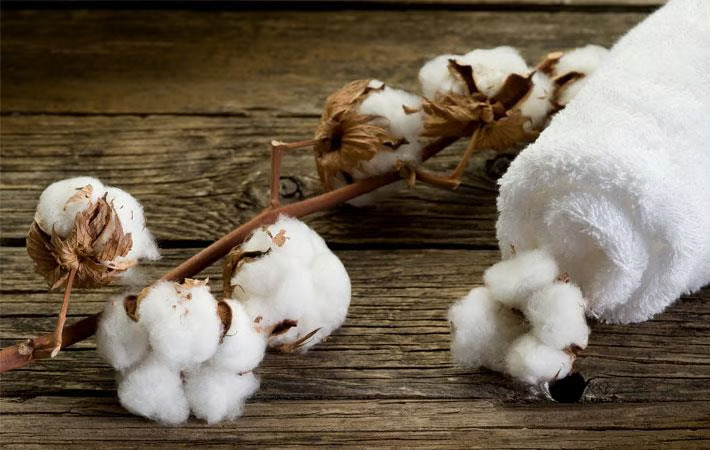FW
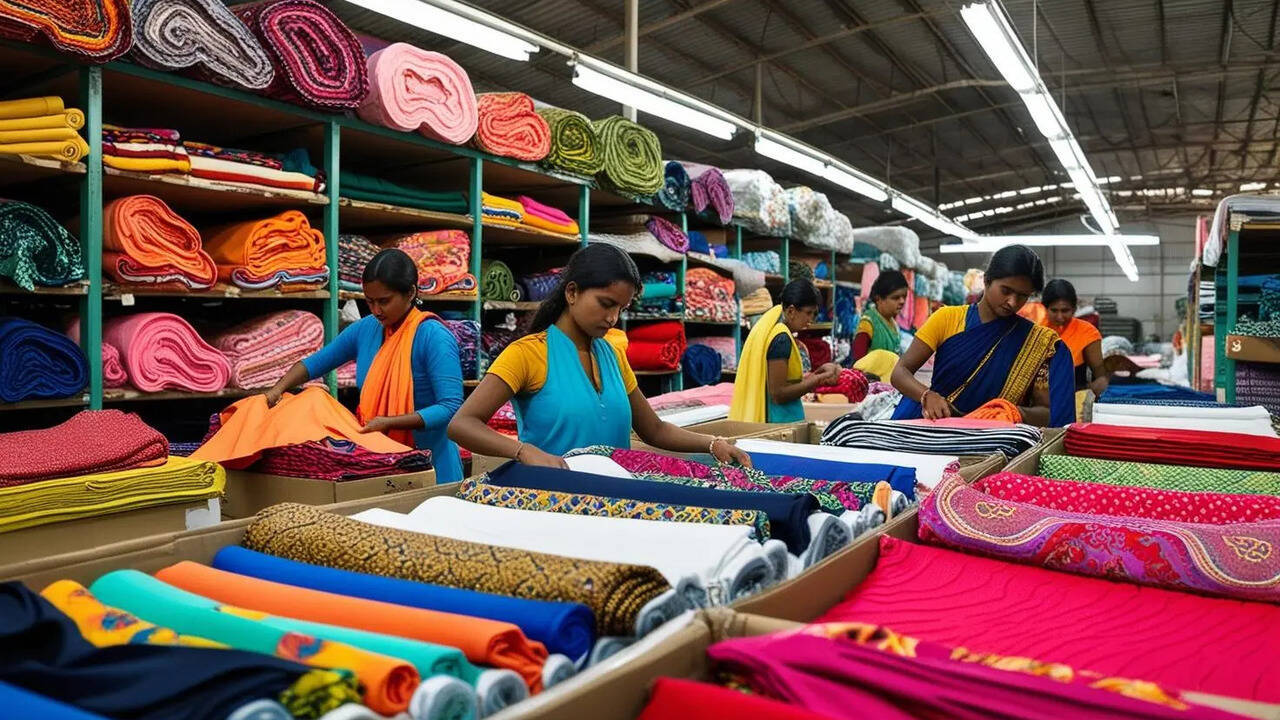
India has moved decisively to restrict fabric imports from Bangladesh, enforcing a port-only policy that bars overland entry of key jute and textile materials. In a fresh notification issued by the Directorate General of Foreign Trade (DGFT), New Delhi declared that specific shipments—including jute products, flax tow, jute yarns, and woven fabrics—will now be allowed entry solely through the Nhava Sheva port in Maharashtra. Effective immediately, the measure is being hailed domestically as a protective step for India's struggling textile sector but is drawing ire in Dhaka as a sign of deepening economic hostility.
The move signals the continuation of a tit-for-tat trade spiral that has escalated sharply since April 2025, when India first withdrew transshipment privileges for Bangladeshi exports to third countries. That was followed by restrictions in May on processed food and ready-made garment (RMG) imports. Now, with the jute segment under the scanner, the fault lines in Indo-Bangladesh trade relations are fully exposed.
What the restriction entails
As per the DGFT's new guidelines, imports of the affected categories are now barred from entering India through any of the land customs stations along the India-Bangladesh border. This includes critical transit points like Petrapole and Benapole, which have long served as commercial arteries between the two neighbours. The only exception: Bangladeshi goods transiting through India en route to Nepal and Bhutan will still be permitted. However, re-exports from these countries back into India have been explicitly prohibited—a clause designed to thwart alleged third-country circumvention tactics.
Trade disruption or domestic revival?
The decision comes with both economic risks and political rewards. Bangladeshi exporters, especially in the RMG and jute segments, will face longer delivery cycles and increased freight costs. Previously, land shipments to India could arrive within 3–4 days. Now, with ocean transit through Nhava Sheva, the wait time stretches to 7–10 days or more.
For Indian retailers and consumers, this could translate into a 2–3 per cent price uptick for winter apparel like T-shirts, jackets, and jeans, especially if the disrupted flow persists into the festival season. But for India’s domestic textile manufacturers—particularly those in jute and cotton weaving hubs—the shift is a potential lifeline.
“This move plugs a significant policy loophole. It not only addresses dumping concerns but helps channel demand back to Indian mills,” says Rajat Mehta, Director, Eastern Textiles Association. “We anticipate a Rs 1,500 crore uptick in capacity utilization by mid-2026 if these measures hold.”
The government, too, is framing this within the larger Atmanirbhar Bharat (self-reliant India) campaign. By stemming the flow of low-cost or allegedly subsidized Bangladeshi imports, it aims to give Indian producers a much-needed competitive edge.
Table : India-Bangladesh trade March 2025
|
Category |
India's exports to Bangladesh ($) |
India's imports from Bangladesh ($) |
|
Total Trade |
$973M |
$171M |
|
Top Indian Exports |
||
|
Cotton Yarn |
$150M |
|
|
Rice (Other Than Basmati) |
$116M |
|
|
Petroleum Products |
$58M |
|
|
Top Bangladeshi Exports |
||
|
RMG (Cotton & Accessories) |
$34.7M |
|
|
Footwear (Leather) |
$14.7M |
|
|
RMG (Other Textile Material) |
$12.3M |
Source: The Observatory of Economic Complexity (OEC), March 2025 data
Unequal trade and the jute flashpoint
Underlying the policy move is a long-simmering grievance: the fate of India’s jute industry. While Bangladesh has built a robust export ecosystem around jute—thanks to subsidies and duty-free access under the South Asian Free Trade Area (SAFTA)—India's jute producers have struggled with falling prices, unpaid dues, and frequent mill shutdowns. “Our farmers are losing out due to under-invoiced and low-grade jute flooding Indian markets,” said Pradeep Saha, a jute grower from Murshidabad, West Bengal. “Government MSP means little when imported jute is sold at below cost.”
India alleges that Bangladesh's jute exports are subsidized and occasionally mislabeled to avoid existing anti-dumping duties. The port-only restriction is intended not just to control volumes but also to enable more thorough quality inspections and prevent regulatory evasion.
Table: India’s jute & textile bast fibre imports from Bangladesh
|
Fiscal year |
Value ($ mn) |
|
FY2017 |
138 |
|
FY2022 |
117 |
|
FY2024 |
144 |
|
2024 |
87.18 (Annualized) |
An eye for an eye: reciprocal restrictions
This hardening of India’s stance coincides with regulatory steps by the Bangladeshi interim administration under Muhammad Yunus, which has blocked Indian yarn and rice exports through land ports, citing the need to shield its own farmers and weavers. Bilateral trade, while still significant at nearly $13 billion, is increasingly marked by protectionism and friction.
“There’s a risk of long-term economic decoupling,” warned Prof. Nusrat Rahman of Dhaka University’s Centre for Trade Policy. “If both sides continue to weaponize trade policy, informal markets may surge and regional economic cooperation will suffer.”
The road ahead
India’s decision to reroute Bangladeshi fabric imports exclusively through Nhava Sheva port may fulfill short-term domestic goals, but it raises broader questions about regional economic integration and diplomatic tact. The impact will reverberate through textile supply chains, price-sensitive retail segments, and border economies where cross-border trade is a livelihood, not just a statistic.
As both nations dig into protectionist positions, a constructive dialogue—perhaps through SAARC or BIMSTEC—may be the only way to prevent economic rivalry from becoming a full-fledged trade war. Until then, fabric isn’t the only thing under strain; so is the very fabric of bilateral trust.

In what’s being described as a high-stakes recalibration of global trade, a newly signed trade agreement between the US and Vietnam is sending ripples through the world’s apparel and textile supply chains. Touted by the Trump administration as a "Great Deal of Cooperation," the pact replaces the 2000 Bilateral Trade Agreement (BTA), ushering in stricter tariff rules that are already prompting global fashion brands to rethink their sourcing strategies.
But beneath the headlines lies a more complex story—of shifting power equations, transshipment crackdowns, and a stark warning for India, which is now in its own critical phase of negotiating a trade deal with Washington.
From preferential access to flat tariffs
The previous BTA between the US and Vietnam granted Vietnamese exporters preferential tariff rates ranging between 2 per cent to 10 per cent, helping transform Vietnam into a sourcing powerhouse. But under the new agreement, all Vietnamese exports to the US now face a flat 20 per cent tariff, while US goods will enter Vietnam duty-free.
“This is a double-edged sword,” said a trade official familiar with the negotiations. “While it opens up the Vietnamese consumer market to American brands, it significantly erodes the competitive advantage Vietnam enjoyed in textiles, furniture, and electronics.” The change also follows allegations from US officials, including Peter Navarro, that Vietnam was acting as a backdoor for Chinese goods seeking to evade US tariffs. These claims have materialized into one of the deal’s most consequential clauses: a 40 per cent duty on transshipped goods.
Transshipment clause, Vietnam’s China dilemma
At the heart of the new deal lies a contentious provision—a punitive 40 per cent tariff on goods exported from Vietnam but manufactured in other countries, particularly China. This move directly targets the widespread practice of transshipment, where Chinese-origin goods are rerouted via Vietnam with minimal processing.
For the $52 billion apparel trade between Vietnam and the US, this spells disruption. Roughly 70 per cent of Vietnamese apparel exports to the US depend on Chinese fabrics or components. Under the new rules, these products could now be reclassified and hit with the steep 40 per cent levy.
“This clause fundamentally alters how origin is interpreted in global trade,” says Amita Joshi, a trade economist. “If you’re a brand sourcing yarn from China and stitching in Vietnam, you’re no longer safe. The value-added threshold has effectively been tightened.”
Fashion industry fallout
For global brands like Nike, Lululemon, and H&M, Vietnam has long been a vital part of their supply chains. Between 2001 and 2023, Vietnam’s exports in textiles, apparel, footwear, and furniture grew from $800 million to over $135 billion, helped by favorable access to Western markets.
But the 20 per cent flat tariff, while better than the originally proposed 46 per cent, still dampens that growth story. According to Apparel Export Promotion Council (AEPC) data, the new duties could increase landed costs by 8–12 per cent for many US retailers depending on product type and production footprint. “The big fear is not just the tariff. It's the administrative and compliance complexity,” said a sourcing executive from a US retail giant. “You can’t just show an invoice now—you need traceability down to the fiber.”
Table: Vietnam’s top export categories to the US (2023)
|
Category |
Export value ($bn) |
Using Chinese inputs |
|
Apparel & Textiles |
52.4 |
70% |
|
Footwear |
23.1 |
62% |
|
Furniture |
19.7 |
58% |
|
Seafood |
8.2 |
22% |
|
Electronics |
25.6 |
45% |
India’s turn, what the GTRI warns about
As India prepares for its own trade pact with the US, the Global Trade Research Initiative (GTRI) has issued a clear warning: learn from Vietnam’s cautionary tale. “India must negotiate enforceable rules of origin and guard against flat duty structures,” said Ajay Srivastava, Co-founder of GTRI. “Otherwise, Indian exports could end up facing the same unpredictable barriers.”
GTRI’s recommendations for India
• Avoid flat tariffs: These fail to account for sectoral differences and can cripple specific industries.
• Insist on clear origin rules: The complexities and potential legal ambiguities surrounding the 40 per cent transshipment tariff underscore the importance of clear and enforceable rules of origin in trade agreements.
• Prepare for sudden policy shifts: What was a trade advantage yesterday can become a liability overnight.
Table: India-US apparel trade (FY24)
|
Metric |
Value |
|
India’s Apparel Exports to US |
$5.1 Billion |
|
US Share in India’s Apparel Trade |
26% |
|
India’s Fabric Dependence on China |
32% |
Resilience over cheap labor
Global supply chains are already responding. According to a 2025 Fashion Industry Pulse Survey, 43 per cent of brands are looking to diversify sourcing from Vietnam, with increased interest in Mexico, India, and Central America. “Resilience is now the keyword,” said Michelle Hwang, a senior VP at a global apparel group. “Low cost isn’t enough. Brands want agility, transparency, and political safety.”
Table: Brands most dependent on Vietnam
|
Brand |
Vietnam sourcing % |
Comments |
|
Nike |
50% |
High reliance on Vietnamese footwear factories |
|
Lululemon |
35% |
Core leggings and performance gear |
|
Gap Inc. |
28% |
Includes both Old Navy and Banana Republic |
|
Uniqlo (Fast Retailing) |
20% |
Primarily knitwear and casualwear |
Trade policy as a fashion trendsetter
This isn’t just a trade deal—it’s a bellwether for how geopolitics is increasingly shaping retail shelves. The US-Vietnam agreement reflects a world where trade liberalization is no longer a given, and where every tariff line carries strategic weight. For Vietnam, the deal is both a setback and an opportunity to localize more of its supply chain. For the US, it represents a move towards fair trade enforcement.
Indeed, the deal is undeniably sparking concern for global fashion sourcing executives. While Vietnam's cost structure and proximity to Asian markets have positioned it as a preferred sourcing hub, the new tariffs and the strict enforcement of transshipment rules necessitate a strategic reassessment. Companies are now faced with the challenge of balancing cost efficiencies with the imperative of supply chain resilience. This could accelerate the trend of diversifying manufacturing bases away from over-reliance on a single country and exploring new sourcing destinations to mitigate future trade-related disruptions. For India, it’s a warning to tread carefully but also a chance to position itself as a stable, scalable, and rule-abiding sourcing destination.
“In the new global trade order, agility, clarity, and compliance will matter more than just low wages,” opines Joshi. “India’s edge will lie in playing the long game, not chasing short-term wins.”

The digital racks of fashion e-commerce are changing as a new report by BoF Insights ‘The New Era of Fashion E-Commerce’, done in collaboration with Amazon Fashion & Sports in Europe, reveals shifting consumer priorities, with trust, reliability, and convenience now eclipsing fleeting trends and even price as key drivers of online purchasing decisions. The days of ‘more-is-more’ consumption are yielding to a more intentional shopping experience, compelling brands to recalibrate their strategies for a demanding new era.
The report, based on a proprietary survey of fashion shoppers across the EU5 (UK, Germany, France, Italy, and Spain) conducted in April 2025, highlights the value equation in fashion e-commerce is being redefined.
Multi-brand retailers emerge new discovery hubs
The report shows multi-brand retailers are emerging as the dominant force in fashion discovery. Almost 39 per cent of EU5 shoppers surveyed cited these platforms as their primary source of online inspiration. This trend got a boost with increasing economic uncertainty, with 23 per cent of frequent fashion shoppers (those who purchased fashion online more than five times in the last year) opting for large, well-known retailers due to their perceived dependability and convenience.
This fluidity in customer journey, particularly among digitally fluent younger shoppers, necessitates a ubiquitous brand presence. The report underscores the power of multi-channel visibility, with 71 per cent of EU5 consumers agreeing that seeing a brand across multiple channels makes them more likely to trust it.
Ruth Diaz, VP of Amazon Fashion and Sports Europe, emphasizes this point and says “Today’s fashion customer moves fluidly across diverse channels, which is why we focus on creating exciting experiences that meet them where they are, wherever and however they want to shop.” She says, they know that when brands create multiple touchpoints, customer engagement increases dramatically.
The rise of practical value
Perhaps the most significant revelation from the report is the waning importance of trendiness. Only 12 per cent of EU5 customers surveyed prioritize trendiness when shopping for fashion online. This is a stark departure from the pre-pandemic era, where "ephemeral fashion trends" and "disposability" were more pronounced, as observed by Doug Stephens, Founder and Chief Executive of Retail Prophet. Instead, shoppers are now seeking tangible benefits that address the inherent pain points of online shopping. The report highlights critical customer priorities:
Table: Top customer priorities in online fashion shopping (EU5)
|
Priority |
Focus |
|
Reliability |
Consistent delivery, accurate product representation |
|
Fit Confidence |
Ability to predict the right size and fit |
|
Clear Product Info |
Comprehensive details, high-quality images |
|
Personalisation |
Tailored recommendations, size guidance |
|
Durability & Quality |
Longevity of the product, material integrity |
Over 40 per cent of EU5 customers surveyed cited personalized size recommendations as a top factor influencing their online fashion purchasing behavior. This demand is leading to the rapid adoption of nascent technologies like immersive 3D product views and AI-powered personalization, which are transitioning from "nice-to-haves" to "must-haves."
For example, Amazon Fashion & Sports' AI-powered size and fit recommendations exemplify this shift. The report notes that over 90 per cent of Amazon customers who buy the recommended size report satisfaction with their purchase, demonstrating the tangible impact of such innovations on customer confidence and loyalty.
The new loyalty driver
In a competitive landscape where customer loyalty is increasingly difficult to secure, consistency across all channels is paramount. Whether a customer encounters a brand on social media, its own website, or a multi-brand retailer, the expectation for a seamless and high-quality experience remains constant.
Beyond the front-end experience, "what happens behind the scenes matters just as much," the report emphasizes. Operational excellence, encompassing fulfillment accuracy and logistics speed, is rapidly becoming a key differentiator. Brands that can consistently deliver on promises of reliability and convenience are not only converting more customers but also fostering long-term loyalty and unlocking incremental growth.
The report therefore, serves as a critical guide for brands navigating this evolving digital landscape. By prioritizing trust, convenience, and a deep understanding of evolving customer expectations, fashion businesses can not only meet rising demands but also forge lasting connections in a highly competitive market.
Experiencing a significant expansion, the global technical textile market is projected to grow to a value of $331.8 billion by 2032, up from $191.7 billion in 2022. This represents a robust Compound Annual Growth Rate (CAGR) of 5.7 per cent from 2023 to 2032, according to a comprehensive report by Allied Market Research.
This impressive growth is primarily driven by escalating demand across several key industries, including automotive, healthcare, construction, and agriculture. Advancements in textile manufacturing technologies, such as the integration of smart textiles and nanotechnology, are also playing a crucial role by enhancing the performance, durability, and overall functionality of these specialized materials. Concurrently, a strong global push towards sustainability is reshaping material choices, with both eco-conscious consumers and new regulations driving the adoption of biodegradable and recycled alternatives. Furthermore, robust economic growth and improved living standards in emerging economies are expanding the everyday applications of technical textiles.
The market is currently witnessing several transformative trends. The integration of sensors and conductive fibers is revolutionizing applications. This includes their use in healthcare monitoring, advanced sportswear, and cutting-edge wearable technology, offering new possibilities for personal and industrial use.
There's a notable surge in demand for recycled PET-based geotextiles and agro-textiles. The industry is increasingly emphasizing bio-based fibers, low-energy production methods, and waterless dyeing techniques to minimize environmental impact.
Technical textiles like geotextiles and non-woven fabrics are seeing increased adoption. They're critical for soil stabilization, erosion control, and filtration, especially in the rapidly developing infrastructure projects of emerging markets.
The automotive and aerospace sectors are driving demand for technical textiles with enhanced fire retardant, lightweight, and high-strength properties. These innovations are crucial for improving safety and achieving better fuel efficiency in vehicles and aircraft.
The National Cotton Council (NCC ) applauds the US House of Representatives for their diligent work and unwavering support in passing the One Big Beautiful Bill Act (OBBA), states Patrick Johnson, Chairman, NCC.
Marking a significant stride forward for cotton producers, the entire cotton supply chain, and the broader agricultural community, this legislation provides vital support, enabling us to continue supplying the world with the highest quality fiber while navigating persistent challenges, he adds.
The legislation is likely to be implemented in close collaboration with the USDA to help ensure that the benefits of the OBBBA are fully realized across the nation.
Growing at a CAGR of 7.8 per cent from 2021-30, the global yoga clothing market is projected to reach a value of $70,291.0 million by 2030, as per a report by Allied Market Research.
This expansion is largely fueled by a significant increase in obesity rates and health-related ailments worldwide, driving more consumers to embrace fitness practices like yoga.
The market's growth is also propelled by the rising consumer inclination to purchase specialized accessories, including yoga apparel, blocks, and mats. Furthermore, concerted efforts by governments and fitness organizations globally to promote yoga have substantially heightened awareness of its numerous health benefits.
By product type, the bottom wear segment is anticipated to experience the fastest growth, with an estimated CAGR of 8.1 per cent during the forecast period. This growth is linked to the increasing number of yoga practitioners and ongoing R&D investments aimed at enhancing the comfort and functionality of yoga wear.
In terms of end-users, the women's segment dominated the market in 2020, valued at $20,520.7 million and capturing 60.9 per cent of the global share. This dominance is attributed to increased aesthetic awareness among women and the influence of female celebrities promoting yoga.
Regionally, North America remains a prominent market, with the US leading the charge. The US market is projected to reach $5,855.5 million by 2030, growing at a CAGR of 6.4 per cent0. Specialty stores were the leading distribution channel in 2020, accounting for 60.8 per cent of the market, primarily due to their strong presence in developed markets like North America and Europe.
The COVID-19 pandemic spurred increased participation in yoga and home-based fitness activities as people became more health-conscious and utilized online platforms. However, the initial lockdown phases led to manufacturing halts and supply chain disruptions, causing some losses for the yoga clothing industry. Despite these short-term setbacks, the underlying trend of increased health awareness reinforced the long-term growth prospects for the market.
Leading players in the yoga clothing market, including Nike, Puma, Asics, Under Armour, Inc., Adidas, Lululemon Athletica, Manduka, Prana, Hugger Mugger, and Aurorae Yoga, LLC., continue to employ various strategies to expand their market share and capitalize on growth opportunities.
Just ahead of the expiration of a 90-day pause on ‘reciprocal’ tariffs affecting numerous US trade partners, President Donald Trump has entered into a new trade agreement with Vietnam that reduces the import tax levied on goods from the country to 20 per cent from the earlier proposed 46 per cent.
Signed between Donald Trump and Lam, General Secretary, Communist Party of Vietnam, this ‘Great Deal of Cooperation,’ outlines, Vietnam will pay a 20 per cent tariff on all goods shipped to the US and a 40 per cent tariff on any ‘transshipping"’– meaning goods from other countries routed through Vietnam for final shipment to the United States.
Conversely, as part of this new agreement, Vietnam has pledged to grant the US total access to its markets with a zero-tariff rate, allowing American products to be sold there duty-free.
This agreement adjusts the general tariff rate against Vietnamese goods, which had been at 10 per cent during the 90-day pause initiated on April 9. The original ‘reciprocal’ tariff plan included a baseline 10 per cent duty for most trading partners and higher tariffs on specific goods like vehicles and auto parts.
Vietnam stands as the seventh-largest US trading partner, with two-way commerce totaling $149.6 billion in 2024. Last year, US imports from Vietnam reached $136.6 billion, primarily comprising apparel, electrical machinery, and footwear. Top US exports to Vietnam include raw cotton, integrated circuits, and telecommunications equipment.
The Central Government plans a develop a PM-MITRA park in Virudhnagar, Tamil Nadu with an investment of Rs 1,900 crore, To be developed on 1,052-acre, this facility will serve as a world-class hub for technical textiles and integrated manufacturing, says A Saktivel, Vice Chairman, AEPC.
. Featuring a 15 million litres per day Zero Liquid Discharge Common Effluent Treatment Plant, this comprehensive park will provide accommodation facilities for 10,000 workers, and over 1.3 million sq ft of ready-to-use infrastructure.
Expected to attract investments worth Rs 10,000 crore, this facility will also create employment opportunities for more than one lakh people by 2026.
The park will help enhance, Tamil Nadu's competitive position in value-added, sustainable, and export-oriented apparel manufacturing. AEPC will provide plug-and-play manufacturing facilties in these parks in collaboration with both Central and State government authorities.
The project is a result of the state government's ongoing engagement and sustained efforts for Tamil Nadu's textile industry, states Sakthivel.
The recently concluded Global Sourcing Expo Australia (June 17-19) in Sydney served as a vibrant testament to a significant shift in Australia's global sourcing strategy. As the nation's only dedicated sourcing exhibition for apparel, footwear, textiles, and homewares, the event highlighted a growing pivot towards diversified, resilient, and ethically conscious supply chains, with India emerging as a key partner. This transformation is largely driven by the India-Australia Economic Cooperation and Trade Agreement (ECTA) and Australia's increasing demand for sustainable products.
The shifting sands of sourcing
Australia, a nation with high fashion consumption is grappling with the environmental impact of its textile waste.This challenge has spurred a pronounced consumer demand for sustainable and ethically produced goods. Simultaneously, global trade disruptions and the strategic imperative to diversify away from over-reliance on single markets (often termed "China Plus One" strategies) are reshaping Australia's import landscape.
This evolving demand creates a fertile ground for countries like India, which boasts a robust textile and apparel sector contributing 12% to its total exports. India's industry is increasingly focusing on eco-friendly materials and ethical practices, aligning perfectly with Australia's burgeoning sustainability preferences.
ECTA: The game changer for India's exports
The India-Australia Economic Cooperation and Trade Agreement (ECTA), effective since December 29, 2022, has been a pivotal force in this reorientation. By eliminating tariffs on nearly 96% of Indian textile and apparel exports to Australia (set to reach 100% by January 1, 2026) , ECTA has leveled the playing field. Previously, Indian textile exporters faced duties of up to 5%. This duty-free access provides a significant competitive edge over traditional suppliers like China, Bangladesh, and Vietnam. The impact is already evident in trade figures:
India's Apparel Exports to Australia (Value in USD Million)
|
Year |
Knitted Garments (USD Mn) |
Woven Garments (USD Mn) |
Total (USD Mn) |
Growth % |
|
2019-2020 |
87.38 |
127.91 |
215.29 |
– |
|
2020-2021 |
93.12 |
111.8 |
204.92 |
-4.81 |
|
2021-2022 |
123.96 |
152.06 |
276.02 |
34.68 |
|
2022-2023 |
131.93 |
170.75 |
302.68 |
9.65 |
|
2023-2024 |
138.25 |
182.79 |
321.04 |
6.07 |
This data shows consistent growth, particularly the 34.68% surge in 2021-2022 (pre-ECTA anticipation) and sustained growth post-implementation. While China still dominates Australia's textile and clothing imports with a 57.86% share, India's 6.11% share in 2022 indicates substantial room for expansion, especially with the new tariff advantages.
The Global Sourcing Expo: Bridging continents
The Global Sourcing Expo, which just wrapped up, served as a critical platform for Indian exporters to capitalize on these opportunities. Leading organizations actively participated, showcasing India's strengths and its commitment to sustainable practices. Such events facilitate direct engagement between Indian suppliers and Australian buyers, fostering new partnerships and providing invaluable market insights.
Evolving business models and success stories
Indian exporters are adapting their business models to meet Australian market demands. Beyond traditional B2B wholesale, there's a growing emphasis on direct-to-consumer (D2C) and e-commerce channels, leveraging Australia's booming online retail market, where fashion and apparel e-commerce holds a 17.4% share.
The Rise of Sustainable Textiles A notable outcome of ECTA has been the "enhanced interest from Australian retailers in Indian sustainable textiles". This reflects a growing alignment between India's production capabilities in organic and cotton textiles and Australia's consumer demand for ethical sourcing.
Artisanal and Handicraft Appeal The Australian market also shows strong appreciation for Indian textiles and clothing "because they are well-made and have unique patterns". The sizable Indian diaspora in Australia further fuels demand for authentic Indian products, including traditional apparel like kurtas and lehengas.
Navigating challenges, seizing the future
Despite the promising outlook, challenges persist, including intense competition from established players and logistical complexities within India. However, the ongoing negotiations for a Comprehensive Economic Cooperation Agreement (CECA) signal a long-term commitment to deepening bilateral economic ties, promising further trade liberalization and sectoral expansion.
The Indian government aims to triple its overall textile exports to approximately US$108 billion by 2030 , with a specific target to increase textile and apparel exports to Australia from USD 392 million to USD 1100 million over the next three years. This ambitious vision, coupled with Australia's evolving sourcing needs, paints a promising picture for a stronger, more diversified, and sustainable textile trade relationship between the two nations.
Upcoming Free Trade Agreements (FTAs) with the United States, the United Kingdom, and the European Union are expected to unlock significant growth opportunities for India's textile sector with exports rising to $100 billion by 2030 from the current $34 billion, said Pabitra Margherita, Union Minister of State for Textiles at the 73rd India International Garment Fair (IIGF) at Yashobhoomi.
Margherita underscored the strategic importance of these FTAs, stating that negotiations with the EU and the US, along with the India-UK FTA, will open new avenues for growth. She emphasized, these are ‘high-value, quality-conscious markets,’ and India is committed to equipping its exporters with the necessary strategies, standards, and compliance to capitalize on these opportunities.
The textile and apparel industry plays a crucial role in the Indian economy, contributing 2.3 per cent to the GDP, 13 per cent to industrial output, and 12 per cent to national exports. In FY23-24, India's textile exports reached $34.4 billion, with apparel accounting for a significant 42 per cent of that total. Margherita emphasized, achieving the $100 billion export target by 2030 will require the active participation of every MSME, entrepreneur, and exporter.
The ongoing three-day IIGF, organized by the Apparel Export Promotion Council (AEPC), features over 360 exhibitors from across India and buyers from 80 countries. Margherita lauded the event as Asia's largest garment fair, showcasing India's rich creativity and craftsmanship. Buyers from diverse regions including North America, Europe, Asia, and Africa are attending.
Given that over 80 per cent of India's textile sector is driven by MSMEs, Margherita emphasized on the need to boost productivity, ensure consistent raw material supply, and minimize import dependency to maintain global competitiveness. Sudhir Sekhri, Chairman, AEPC added, the fair serves as a vital platform for promoting 'Made in India' fashion globally. He projected India's garment exports to reach $40 billion by 2030, noting a commendable 12.8 per cent cumulative growth in apparel exports during the first two months of FY2025-26, despite global challenges

